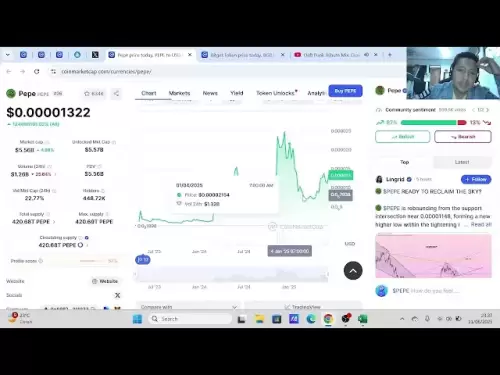-
 Bitcoin
Bitcoin $108,889.8084
-0.81% -
 Ethereum
Ethereum $2,820.7248
1.62% -
 Tether USDt
Tether USDt $1.0001
0.01% -
 XRP
XRP $2.2946
-0.26% -
 BNB
BNB $667.5348
0.01% -
 Solana
Solana $163.1955
-0.68% -
 USDC
USDC $0.9998
0.01% -
 Dogecoin
Dogecoin $0.1952
0.01% -
 TRON
TRON $0.2822
-3.29% -
 Cardano
Cardano $0.7056
-0.52% -
 Hyperliquid
Hyperliquid $42.3451
2.52% -
 Sui
Sui $3.4321
-0.90% -
 Chainlink
Chainlink $15.1702
-0.54% -
 Avalanche
Avalanche $21.8254
-2.44% -
 Stellar
Stellar $0.2791
0.06% -
 Bitcoin Cash
Bitcoin Cash $436.7091
0.31% -
 UNUS SED LEO
UNUS SED LEO $9.0234
3.09% -
 Toncoin
Toncoin $3.2576
-1.49% -
 Shiba Inu
Shiba Inu $0.0...01322
0.08% -
 Hedera
Hedera $0.1760
-2.66% -
 Litecoin
Litecoin $92.2057
0.26% -
 Polkadot
Polkadot $4.2486
-0.88% -
 Monero
Monero $326.1263
-4.20% -
 Ethena USDe
Ethena USDe $1.0006
0.00% -
 Bitget Token
Bitget Token $4.8236
0.40% -
 Pepe
Pepe $0.0...01278
-1.09% -
 Dai
Dai $0.9998
0.01% -
 Uniswap
Uniswap $8.0639
-3.53% -
 Pi
Pi $0.6359
-1.17% -
 Aave
Aave $307.7143
0.18%
What is the significance of the dawn pattern? How to verify the effectiveness of the reversal?
The dawn pattern, a bullish reversal signal in crypto, consists of three candles and is confirmed by volume, moving averages, and RSI for effective trading.
Jun 10, 2025 at 11:07 pm
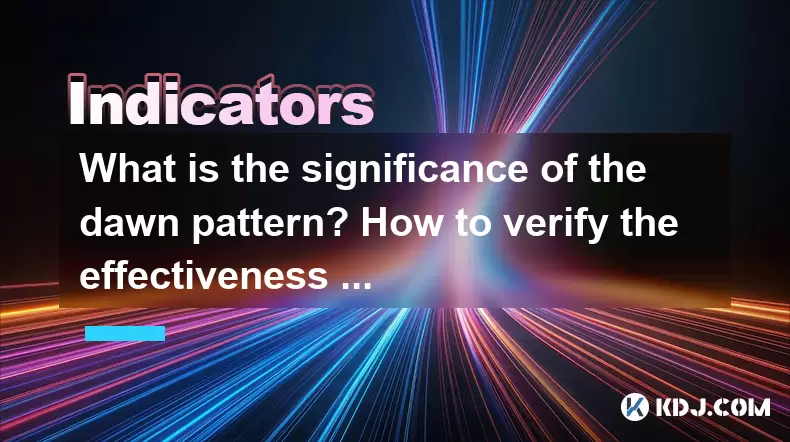
The dawn pattern, also known as the morning star pattern, is a significant bullish reversal pattern in the cryptocurrency market that traders use to identify potential trend reversals from bearish to bullish. This pattern typically forms at the end of a downtrend and signals that the bears might be losing control, paving the way for the bulls to take over. Understanding and verifying the effectiveness of the dawn pattern is crucial for traders looking to capitalize on these potential reversals.
Understanding the Dawn Pattern
The dawn pattern consists of three candles and is named after its resemblance to a morning star rising in the sky. The pattern is characterized by the following components:
- First candle: A long bearish candle that continues the existing downtrend.
- Second candle: A small-bodied candle that gaps down from the first candle. This candle can be bullish or bearish and represents a period of indecision in the market.
- Third candle: A long bullish candle that gaps up from the second candle, indicating a strong reversal of the previous downtrend.
The significance of the dawn pattern lies in its ability to signal a potential shift in market sentiment from bearish to bullish. When this pattern appears at the end of a downtrend, it suggests that the selling pressure is diminishing, and buyers are starting to regain control.
Identifying the Dawn Pattern on a Chart
To identify the dawn pattern on a cryptocurrency chart, traders should look for the following sequence of candles:
- A long bearish candle that signifies the continuation of the downtrend.
- A small-bodied candle that gaps down from the first candle. This candle can be either bullish or bearish.
- A long bullish candle that gaps up from the second candle, indicating a strong bullish reversal.
Traders can use various charting tools and platforms to draw these patterns and analyze their formation. It is essential to confirm the pattern with additional technical indicators to increase the probability of a successful trade.
Verifying the Effectiveness of the Reversal
Verifying the effectiveness of the dawn pattern's reversal involves several steps and the use of additional technical indicators. Here are some methods traders can use to confirm the pattern:
- Volume Analysis: An increase in trading volume on the third candle of the dawn pattern can confirm the strength of the bullish reversal. Higher volume suggests that more traders are participating in the move, increasing the likelihood of a sustained uptrend.
- Moving Averages: Traders can use moving averages to confirm the reversal. If the price moves above a key moving average, such as the 50-day or 200-day moving average, it can signal a confirmed bullish trend.
- Relative Strength Index (RSI): The RSI can help traders identify overbought or oversold conditions. If the RSI moves from an oversold condition (below 30) to a neutral or overbought condition (above 70) following the dawn pattern, it can confirm the reversal.
- Support and Resistance Levels: If the price breaks above a significant resistance level after forming the dawn pattern, it can confirm the bullish reversal. Conversely, if the price fails to break above resistance, it may indicate a false signal.
Practical Steps to Trade the Dawn Pattern
To trade the dawn pattern effectively, traders should follow these steps:
- Identify the Pattern: Use charting tools to identify the dawn pattern at the end of a downtrend.
- Confirm the Pattern: Use additional technical indicators like volume, moving averages, RSI, and support/resistance levels to confirm the reversal.
- Set Entry and Exit Points: Once the pattern is confirmed, set a clear entry point, typically above the high of the third candle. Set a stop-loss order below the low of the first candle to manage risk.
- Monitor the Trade: Continuously monitor the trade to ensure it aligns with the expected bullish trend. Adjust stop-loss and take-profit levels as necessary based on market conditions.
Risk Management and the Dawn Pattern
Effective risk management is crucial when trading the dawn pattern. Here are some risk management strategies traders should consider:
- Position Sizing: Determine the appropriate position size based on the risk-reward ratio and overall trading strategy. Never risk more than a small percentage of the trading capital on a single trade.
- Stop-Loss Orders: Always use stop-loss orders to limit potential losses. Place the stop-loss order below the low of the first candle in the dawn pattern.
- Take-Profit Orders: Set take-profit orders at logical resistance levels to secure profits. Adjust these levels based on the strength of the bullish trend.
- Diversification: Avoid putting all capital into a single trade. Diversify across different cryptocurrencies and trading strategies to mitigate risk.
Real-World Examples of the Dawn Pattern
To illustrate the effectiveness of the dawn pattern, let's consider a few real-world examples from the cryptocurrency market:
- Bitcoin (BTC): In early 2020, Bitcoin formed a dawn pattern after a significant downtrend. The pattern was confirmed by a surge in trading volume and a break above the 50-day moving average. The subsequent bullish trend saw Bitcoin's price increase by over 300% in the following months.
- Ethereum (ETH): In mid-2021, Ethereum exhibited a clear dawn pattern after a period of consolidation. The pattern was confirmed by a strong bullish candle and a break above a key resistance level. Ethereum's price then rallied by over 50% in the weeks following the pattern.
These examples demonstrate how the dawn pattern can signal significant bullish reversals in the cryptocurrency market when properly identified and confirmed.
Frequently Asked Questions
Q: Can the dawn pattern be used in conjunction with other reversal patterns?
A: Yes, the dawn pattern can be used alongside other reversal patterns like the hammer or engulfing pattern to increase the confidence in a potential bullish reversal. Combining multiple patterns and indicators can provide a more robust trading strategy.
Q: How reliable is the dawn pattern in predicting bullish reversals?
A: The reliability of the dawn pattern depends on various factors, including market conditions and the strength of the confirmation signals. While the pattern can be highly effective when confirmed by volume, moving averages, and other indicators, it is not foolproof. Traders should always use proper risk management techniques.
Q: Are there any specific cryptocurrencies where the dawn pattern works better?
A: The dawn pattern can be applied to any cryptocurrency, but it may be more effective in highly liquid assets like Bitcoin and Ethereum due to their larger trading volumes and clearer price movements. However, the pattern's effectiveness ultimately depends on the trader's ability to confirm it with other technical indicators.
Q: How can traders differentiate between a true dawn pattern and a false signal?
A: To differentiate between a true dawn pattern and a false signal, traders should look for confirmation from multiple technical indicators. A true dawn pattern will typically be accompanied by increased trading volume, a break above key moving averages, and a shift in the RSI from oversold to neutral or overbought conditions. If these confirmations are absent, the pattern may be a false signal.
Disclaimer:info@kdj.com
The information provided is not trading advice. kdj.com does not assume any responsibility for any investments made based on the information provided in this article. Cryptocurrencies are highly volatile and it is highly recommended that you invest with caution after thorough research!
If you believe that the content used on this website infringes your copyright, please contact us immediately (info@kdj.com) and we will delete it promptly.
- CFTC Announces Default Judgment Against Mark Gillespie and John Roche in My Big Coin Digital Asset Fraud Scheme
- 2025-06-12 03:14:16
- Kaia [KAIA], the native token of the merged Klaytn-Finschia network, surged over 20%
- 2025-06-12 03:12:15
- The Next Top Meme Coin in 2025 Isn't Just Hype, It's Reshaping the Reward, Growth, and Engagement of Meme Coins
- 2025-06-12 03:10:59
- Launch of QFSCOIN's Most Profitable Bitcoin Mining Service in 2025
- 2025-06-12 03:00:12
- The United States is on the brink of a new technological frontier
- 2025-06-12 03:00:12
- All Heart Piece Locations In The Legend Of Zelda: The Wind Waker
- 2025-06-12 02:56:52
Related knowledge
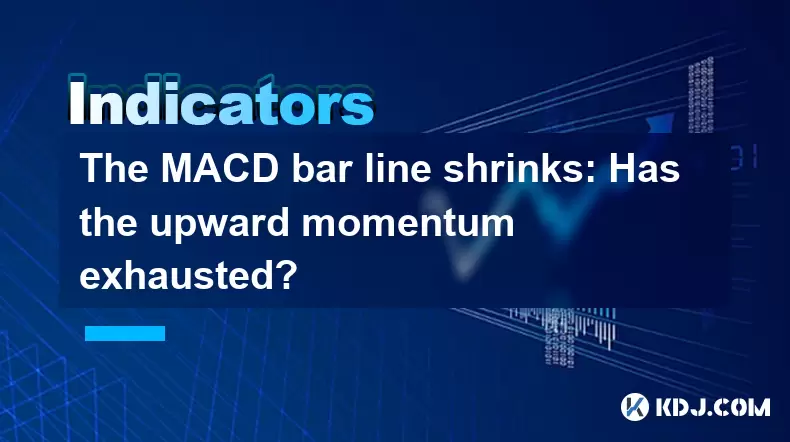
The MACD bar line shrinks: Has the upward momentum exhausted?
Jun 12,2025 at 12:49am
Understanding the MACD Bar LineThe Moving Average Convergence Divergence (MACD) is a widely used technical indicator in cryptocurrency trading. It consists of three main components: the MACD line, the signal line, and the MACD histogram (also known as the bar line). The MACD bar line represents the difference between the MACD line and the signal line. W...

The chip peak moves up: Is the main force quietly shipping?
Jun 12,2025 at 01:01am
Understanding the Chip Peak Movement in Cryptocurrency MiningIn recent years, the chip peak movement has become a critical topic within the cryptocurrency mining community. This phrase typically refers to the point at which mining hardware reaches its maximum efficiency and output capacity. When this peak shifts upward, it often signals changes in the s...
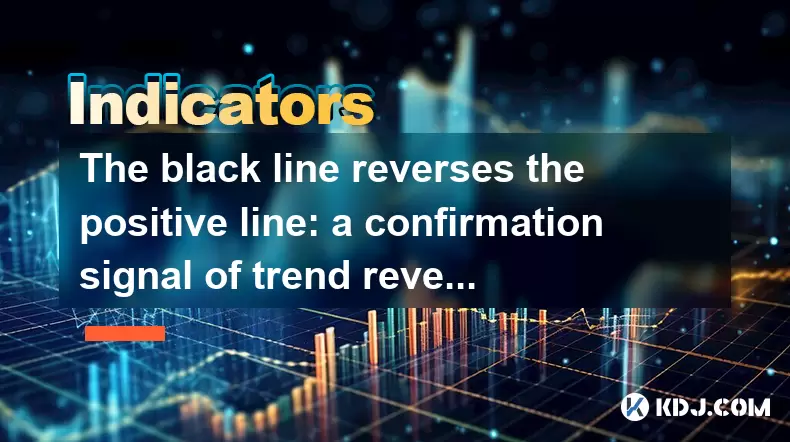
The black line reverses the positive line: a confirmation signal of trend reversal?
Jun 12,2025 at 12:22am
Understanding the Black Line and Positive Line in Technical AnalysisIn the realm of cryptocurrency trading, technical indicators play a crucial role in interpreting price movements. Among these, the MACD (Moving Average Convergence Divergence) is one of the most widely used tools by traders to identify potential trend reversals. Within the MACD indicato...
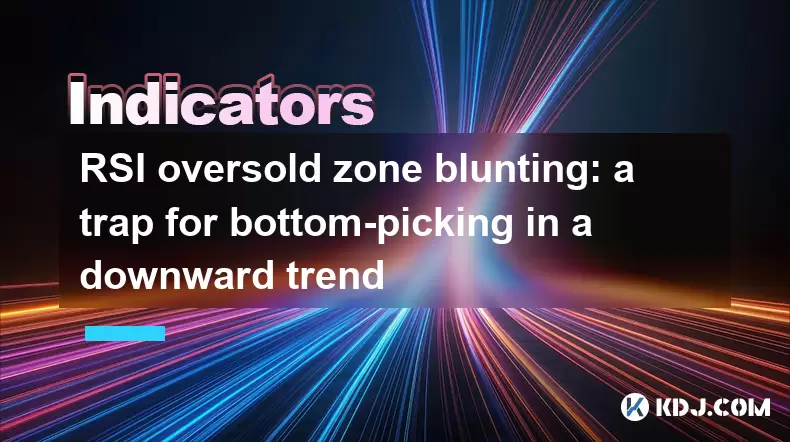
RSI oversold zone blunting: a trap for bottom-picking in a downward trend
Jun 12,2025 at 04:08am
Understanding the RSI IndicatorThe Relative Strength Index (RSI) is a momentum oscillator widely used in technical analysis to evaluate overbought or oversold conditions of an asset. Typically, the RSI ranges from 0 to 100, with levels above 70 indicating overbought territory and levels below 30 signaling oversold conditions. In cryptocurrency trading, ...

Can the bottom three consecutive positives really be bottomed out? Volume is the key indicator
Jun 11,2025 at 08:21pm
Understanding the Bottom Three Consecutive Positives PatternThe bottom three consecutive positives pattern is a candlestick formation often observed in cryptocurrency trading charts. This pattern typically appears after a prolonged downtrend and consists of three consecutive bullish candles following a series of bearish ones. Each positive candle closes...
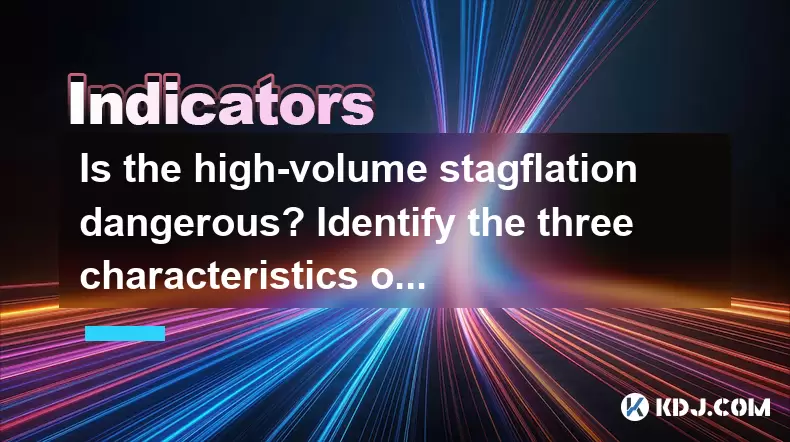
Is the high-volume stagflation dangerous? Identify the three characteristics of the main force's shipment
Jun 11,2025 at 09:08pm
Understanding Stagflation in the Cryptocurrency MarketIn traditional economics, stagflation refers to a period marked by stagnant economic growth, high unemployment, and rising inflation. However, within the cryptocurrency market, stagflation can manifest differently — often described as a phase where prices stagnate despite increasing trading volumes a...

The MACD bar line shrinks: Has the upward momentum exhausted?
Jun 12,2025 at 12:49am
Understanding the MACD Bar LineThe Moving Average Convergence Divergence (MACD) is a widely used technical indicator in cryptocurrency trading. It consists of three main components: the MACD line, the signal line, and the MACD histogram (also known as the bar line). The MACD bar line represents the difference between the MACD line and the signal line. W...

The chip peak moves up: Is the main force quietly shipping?
Jun 12,2025 at 01:01am
Understanding the Chip Peak Movement in Cryptocurrency MiningIn recent years, the chip peak movement has become a critical topic within the cryptocurrency mining community. This phrase typically refers to the point at which mining hardware reaches its maximum efficiency and output capacity. When this peak shifts upward, it often signals changes in the s...

The black line reverses the positive line: a confirmation signal of trend reversal?
Jun 12,2025 at 12:22am
Understanding the Black Line and Positive Line in Technical AnalysisIn the realm of cryptocurrency trading, technical indicators play a crucial role in interpreting price movements. Among these, the MACD (Moving Average Convergence Divergence) is one of the most widely used tools by traders to identify potential trend reversals. Within the MACD indicato...

RSI oversold zone blunting: a trap for bottom-picking in a downward trend
Jun 12,2025 at 04:08am
Understanding the RSI IndicatorThe Relative Strength Index (RSI) is a momentum oscillator widely used in technical analysis to evaluate overbought or oversold conditions of an asset. Typically, the RSI ranges from 0 to 100, with levels above 70 indicating overbought territory and levels below 30 signaling oversold conditions. In cryptocurrency trading, ...

Can the bottom three consecutive positives really be bottomed out? Volume is the key indicator
Jun 11,2025 at 08:21pm
Understanding the Bottom Three Consecutive Positives PatternThe bottom three consecutive positives pattern is a candlestick formation often observed in cryptocurrency trading charts. This pattern typically appears after a prolonged downtrend and consists of three consecutive bullish candles following a series of bearish ones. Each positive candle closes...

Is the high-volume stagflation dangerous? Identify the three characteristics of the main force's shipment
Jun 11,2025 at 09:08pm
Understanding Stagflation in the Cryptocurrency MarketIn traditional economics, stagflation refers to a period marked by stagnant economic growth, high unemployment, and rising inflation. However, within the cryptocurrency market, stagflation can manifest differently — often described as a phase where prices stagnate despite increasing trading volumes a...
See all articles





















